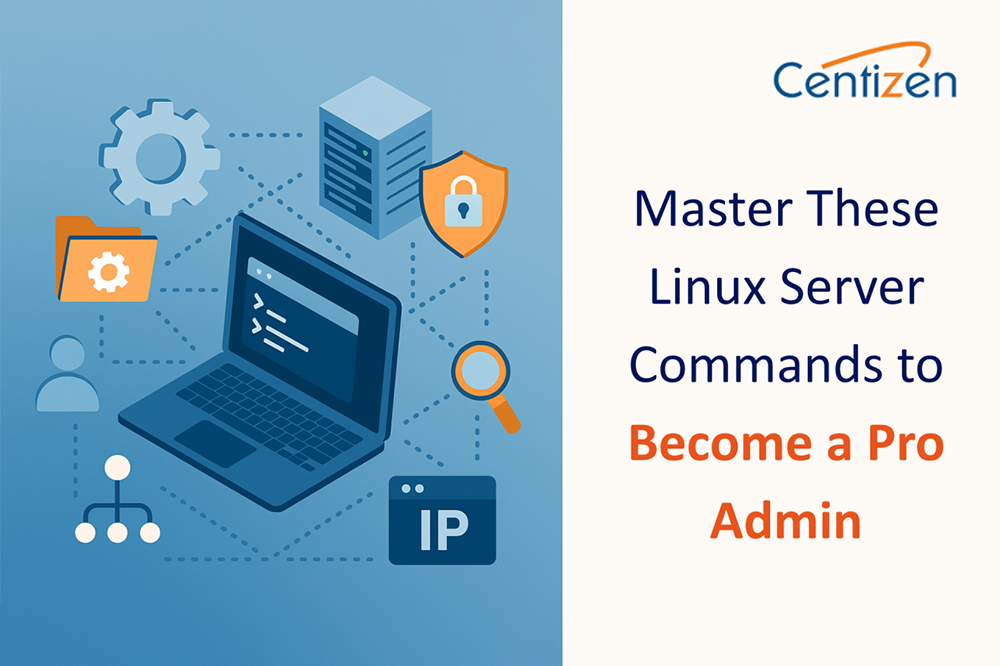Master These Linux Server Commands to Become a Pro Admin

Managing a Linux server isn’t just about uptime—it’s about control, security, and efficiency. Whether you’re new to system administration or looking to sharpen your skills, knowing the right Linux commands can transform how you manage infrastructure.
This guide covers the most essential Linux server commands across user management, networking, security, file systems, and more—giving you the confidence and capabilities to operate like a pro.
User and group management
Proper access control starts with user and group management. Here are the must-know commands:
- useradd, adduser, usermod, userdel – Create, modify, or delete user accounts.
- groupadd, groupmod, groupdel, gpasswd – Manage groups and their permissions.
- passwd – Set or reset user passwords.
- id, whoami, groups – Check user ID and group affiliations.
- chage – Configure password expiration and aging.
Tip: Lock inactive accounts and set password expiration policies to improve security.
File and directory operations
Navigating the file system and manipulating files is fundamental:
- cd, pwd, ls – Move around and inspect directory contents.
- cp, mv, rm, mkdir, rmdir – Copy, move, and delete files and directories.
- find, locate, which, whereis – Search for files or commands.
- stat, file, touch – Retrieve file metadata or create placeholder files.
Tip: Use find / -type f -name “*.log” to quickly locate log files.
File permissions and ownership
Keep your data secure with proper permission settings:
- chmod, chown, chgrp – Set file permissions and change ownership.
- umask – Define default permissions for new files.
- ls -l, getfacl, setfacl – View and manage Access Control Lists (ACLs).
Tip: Use ACLs for more granular permission settings beyond standard Unix permissions.
Package management
Install and update software with these distribution-specific tools:
- Debian/Ubuntu: apt, dpkg
- RHEL/CentOS/Fedora: yum, dnf, rpm
- Universal: snap, flatpak
Tip: Combine with cron to auto-install updates during off-peak hours.
Networking and connectivity
Diagnose and manage network issues with these tools:
- ip, ifconfig, ip a, ip r – Configure and inspect network interfaces and routes.
- ping, traceroute, netstat, ss – Test connectivity and analyze network activity.
- nmap, telnet, curl, wget, dig, nslookup – Test open ports and domain lookups.
- hostname, nmcli, ethtool, tcpdump – View and troubleshoot host and network configs.
Tip: Use tcpdump for packet-level monitoring during suspicious activity.
Log management and system services
Logs are your best friend for diagnosing issues:
- journalctl – View systemd logs.
- systemctl, service – Start, stop, and manage services.
- logger – Add custom entries to logs.
- rsyslog, logrotate – Configure logging and automatic log file rotation.
Tip: Automate logrotate to prevent disk bloat from large logs.
File compression and archiving
Handle backups and storage efficiently:
- tar, gzip, gunzip, bzip2, xz, zip, unzip – Compress and extract files.
Tip: tar -czf backup.tar.gz /etc/ creates a compressed backup of the /etc directory.
Task scheduling
Run scripts or updates automatically with these schedulers:
- cron, crontab – Schedule recurring tasks.
- at, batch – Schedule one-time tasks.
Tip: Always log output of scheduled jobs for easier debugging (>/var/log/job.log 2>&1).
Disk and file system management
Monitor and manage disk usage and partitions:
- mount, umount – Mount and unmount file systems.
- lsblk, blkid, fdisk, parted – Inspect disks and partitions.
- mkfs, fsck, tune2fs – Create or check file systems.
- lsof, fuser – List open files and identify which processes use them.
Tip: Run df -h and du -sh * to identify large files eating up space.
Backup and restore
Avoid data disasters with these backup tools:
- rsync, scp, dd, tar, cpio – Copy and archive data securely.
- timeshift, borg, restic – Create and restore system snapshots.
Tip: Use rsync -aAXv for backups that preserve permissions and ACLs.
Security and access control
Lock down your server with powerful security tools:
- sudo, su – Run commands as root or switch users.
- ssh, sshd – Secure remote connections.
- iptables, firewalld, ufw – Manage firewall rules.
- fail2ban, auditctl, semanage – Monitor and block malicious behavior.
Tip: Disable password-based SSH and enforce key-based logins.
Final thoughts
Becoming a pro Linux admin starts with mastering the right command-line tools. Whether you’re troubleshooting a failing service or scheduling automated backups, the Linux terminal gives you powerful control—once you know how to use it.
Explore, practice, and refine your use of these commands to build confidence and command over your server environments. A well-tuned CLI skillset is the mark of a true systems professional.
Our services:
- Staffing: Contract, contract-to-hire, direct hire, remote global hiring, SOW projects, and managed services.
- Remote hiring: Hire full-time IT professionals from our India-based talent network.
- Custom software development: Web/Mobile Development, UI/UX Design, QA & Automation, API Integration, DevOps, and Product Development.
Our products:
- ZenBasket: A customizable ecommerce platform.
- Zenyo payroll: Automated payroll processing for India.
- Zenyo workforce: Streamlined HR and productivity tools.
Services
Send Us Email
contact@centizen.com
Centizen
A Leading Staffing, Custom Software and SaaS Product Development company founded in 2003. We offer a wide range of scalable, innovative IT Staffing and Software Development Solutions.
Call Us
India: +91 63807-80156
USA & Canada: +1 (971) 420-1700
Send Us Email
contact@centizen.com
Centizen
A Leading Staffing, Custom Software and SaaS Product Development company founded in 2003. We offer a wide range of scalable, innovative IT Staffing and Software Development Solutions.
Call Us
India: +91 63807-80156
USA & Canada: +1 (971) 420-1700
Send Us Email
contact@centizen.com






